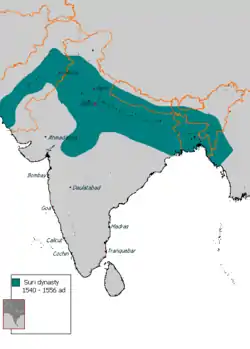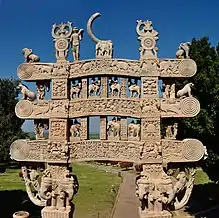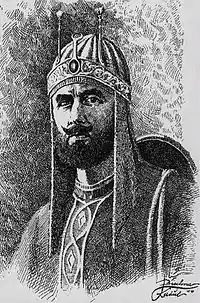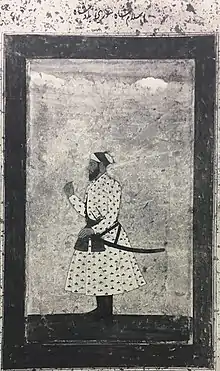Sur Empire
The Sur Empire was an Afghan dynasty[2] which ruled a large territory in the northern part of the Indian subcontinent for nearly 16 years,[3] between 1540 and 1556, with Sasaram, in modern-day Bihar, serving as its capital.[3][4]
Sur Empire | |||||||||
|---|---|---|---|---|---|---|---|---|---|
| 1540–1556 | |||||||||
 Territory of Sur Empire | |||||||||
| Capital | Sasaram | ||||||||
| Common languages | Hindavi, Persian[1] | ||||||||
| Religion | Sunni Islam | ||||||||
| Government | Sultanate | ||||||||
| Padishah | |||||||||
• 1540-1545 | Sher Shah Suri (first) | ||||||||
• 1555-1556 | Adil Shah Suri (last) | ||||||||
| History | |||||||||
• Established | 17 May 1540 | ||||||||
• Disestablished | 1556 | ||||||||
| |||||||||
| Today part of | |||||||||
Part of a series on the |
|---|
| History of India |
 Satavahana gateway at Sanchi, 1st century CE |
| Part of a series on |
| Pashtuns |
|---|
| Kingdoms |
The Sur dynasty held control of nearly all the Mughal territories, from eastern Balochistan in the west to modern-day Bangladesh in the east.
History
Sher shah an ethnic Afghan of the tribal house of Sur,[3] first served as a private before rising to become a commander in the Mughal army under Babur and then the governor of Bihar. In 1537, when Babur's son Humayun was elsewhere on an expedition, Sher Shah overran the state of Bengal and established the Suri dynasty.[5], who supplanted the Mughal dynasty as rulers of North India during the reign of the relatively ineffectual second Mughal Humayun. Sher Shah defeated badshah-i-Hind ('Hindustani emperor') Humayun in the Battle of Chausa (26 June 1539) and again in the Battle of Bilgram (17 May 1540).[5]
Sher Shah Suri was known for the destruction of some old cities while conquering parts of India. He has been accused by `Abd al-Qadir Bada'uni and other Muslim historians for destroying old cities in order to build new ones on their ruins after his own name. One example included Shergarh.[6][7][8] Sher Shah is also said to have destroyed Dinpanah, which Humayun was constructing as the "sixth city of Delhi". The new city built by him, was itself destroyed in 1555 after Humayun re-conquered the territory from the Surs.[9] Tarikh-i-Da'udi states, however, that he destroyed Siri. Abbas Sarwani states that he had the older city of Delhi destroyed. Tarikh-i-Khan Jahan states that Salim Shah Suri had built a wall around Humayun's imperial city.[10]
The Sur dynasty held control of nearly all the Mughal territories, from Balochistan in the west to modern-day Bangladesh in the east.
Their rule came to an end by a defeat that led to the restoration of the Mughal Empire.
It was at the time of this bounty of Sultán Bahlol [Lodi], that the grandfather of Sher Sháh, by name Ibráhím Khán Súr,*The Súr represent themselves as descendants of Muhammad Súr, one of the princes of the house of the Ghorian, who left his native country, and married a daughter of one of the Afghán chiefs of Roh. with his son Hasan Khán, the father of Sher Sháh, came to Hindu-stán from Afghánistán, from a place which is called in the Afghán tongue "Shargarí",* but in the Multán tongue "Rohrí". It is a ridge, a spur of the Sulaimán Mountains, about six or seven kos in length, situated on the banks of the Gumal. They entered into the service of Muhabbat Khán Súr, Dáúd Sáhú-khail, to whom Sultán Bahlol had given in jágír the Parganas of Hariána and Bahkála, etc., in the Panjáb, and they settled in the pargana of Bajwára.[11]
— Abbas Khan Sarwani, 1580
List of Sur dynasty rulers

| Name | Picture | Reign started | Reign ended |
|---|---|---|---|
| Sher Shah Suri |  |
17 May 1532[14] | 22 May 1545[14] |
| Islam Shah Suri |  |
26 May 1545[15] | 22 November 1554[15] |
| Firuz Shah Suri | 1554[16] | ||
| Muhammad Adil Shah | 1554[16] | 1555[17] | |
| Ibrahim Shah Suri | 1555[17] | 1555 | |
| Sikandar Shah Suri | 1555[17] | 22 June 1555[17] | |
| Adil Shah Suri | 22 June 1555[17] | 1556[17] |
See also
- Sur (Pashtun)
- Delhi Sultanate
- List of Sunni Muslim dynasties
References
- Alam, Muzaffar (1998). "The pursuit of Persian: Language in Mughal Politics". Modern Asian Studies. Cambridge University Press. 32 (2): 317–349. doi:10.1017/s0026749x98002947. S2CID 146630389.
Hindavi was recognized as a semi-official language by the Sor Sultans (1540-55) and their chancellery rescripts bore transcriptions in the Devanagari script of the Persian contents. The practice is said to have been introduced by the Lodis (1451–1526).
- Singh, Sarina; Lindsay Brown; Paul Clammer; Rodney Cocks; John Mock (2008). Pakistan & the Karakoram Highway. 7, illustrated. Lonely Planet. p. 137. ISBN 978-1-74104-542-0. Retrieved 23 August 2010.
- Kissling, H. J.; N. Barbour; Bertold Spuler; J. S. Trimingham; F. R. C. Bagley; H. Braun; H. Hartel (1997). The Last Great Muslim Empires. BRILL. pp. 262–263. ISBN 90-04-02104-3. Retrieved 20 July 2011.
- Berndl, Klaus (2005). National Geographic Visual History of the World. National Geographic Society. pp. 318–320. ISBN 978-0-7922-3695-5.
- "Sher Khan". Columbia Encyclopedia. 2010. Retrieved 24 August 2010.
- "Jain inscription from Shergarh (Dr. D. C. Sircar)". South Indian Inscriptions. Manager of Publications, Delhi.
- `Abd al-Qadir Bada'uni (1898). Muntakhab-ut-Tawarikh (English translation (Bib. Ind.) ed.). Calcutta. p. 472.
- Qanungo, K. R. (1921). Sher Shah. p. 404.
- Bolande-Crew, Tara; Lea, David (2 September 2003). The Territories and States of India. ISBN 9781135356255.
- D'Ayala, Diana (2 June 2008). Structural Analysis of Historic Construction: Preserving Safety and Significance. pp. 290, 291. ISBN 9781439828229.
- Abbas Khan Sarwani (1580). "Táríkh-i Sher Sháhí; or, Tuhfat-i Akbar Sháhí, of 'Abbás Khán Sarwání. CHAPTER I. Account of the reign of Sher Sháh Súr". Packard Humanities Institute. Retrieved 4 September 2010.
- Mughal Coinage Archived 16 May 2008 at the Wayback Machine Reserve Bank of India RBI Monetary Museum,
- Chisholm, Hugh, ed. (1911). . Encyclopædia Britannica. 23 (11th ed.). Cambridge University Press. p. 885.
- Majumdar, R.C. (ed.) (2007). The Mughul Empire, Mumbai: Bharatiya Vidya Bhavan, ISBN 81-7276-407-1, p.83
- Majumdar, R.C. (ed.) (2007). The Mughul Empire, Mumbai: Bharatiya Vidya Bhavan, ISBN 81-7276-407-1, pp.90–93
- Majumdar, R.C. (ed.) (2007). The Mughul Empire, Mumbai: Bharatiya Vidya Bhavan, ISBN 81-7276-407-1, p.94
- Majumdar, R.C. (ed.) (2007). The Mughul Empire, Mumbai: Bharatiya Vidya Bhavan, ISBN 81-7276-407-1, pp.94–96
External links
| Wikimedia Commons has media related to Sur Empire. |